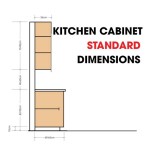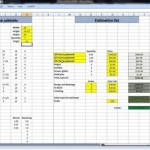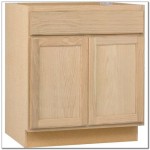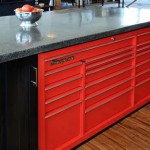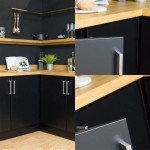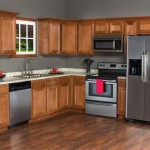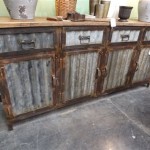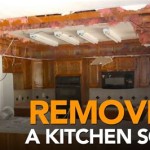Kitchen Cabinet Locks: Ensuring Safety and Security in the Heart of the Home
Kitchen cabinet locks represent a crucial component in home safety strategies, particularly in households with young children, vulnerable adults, or those seeking to secure potentially dangerous items. These locking mechanisms provide a physical barrier against unwanted access to cabinets and drawers, offering peace of mind and contributing to a safer living environment. This article explores the various types of kitchen cabinet locks available, their installation methods, and the factors to consider when selecting the most appropriate locking solution for specific needs.
The presence of cleaning products, medications, sharp objects, and other potentially hazardous materials in kitchens underscores the importance of implementing adequate safety measures. While proper storage practices are essential, they are not always sufficient, especially when dealing with individuals prone to curiosity or those who may not fully comprehend the risks associated with certain items. Kitchen cabinet locks provide an additional layer of protection, mitigating the risk of accidental ingestion, injury, or misuse of these materials.
The market offers a wide array of kitchen cabinet locks, each designed with specific features and functionalities to cater to diverse requirements. From simple magnetic locks to more sophisticated locking systems, understanding the different options available is essential for making an informed decision. The selection process should consider the type of cabinets, the desired level of security, and the ease of installation and use.
Types of Kitchen Cabinet Locks
Several types of kitchen cabinet locks are available, each with its own advantages and disadvantages. Choosing the right type depends on factors such as budget, installation preference, and the level of security desired. Commonly used types include magnetic locks, adhesive locks, spring-loaded latches, and traditional keyed locks.
Magnetic Locks: These locks utilize a powerful magnetic key to disengage the locking mechanism. The lock itself is typically installed inside the cabinet, making it invisible from the outside and preserving the aesthetic appeal of the cabinetry. To open the cabinet, the magnetic key is held against the exterior surface, releasing the catch. Magnetic locks are generally considered highly effective against children but may not deter determined adults. They require careful alignment during installation to ensure proper functionality.
Adhesive Locks: Adhesive locks are relatively easy to install, as they do not require drilling or screwing into the cabinet. They consist of two parts that adhere to the cabinet door and frame or adjoining drawers, preventing them from being opened. These locks are typically made of plastic or other durable materials and are available in various designs. While convenient, adhesive locks may not be as strong as other types and can potentially be removed with force. The quality of the adhesive is a crucial factor in determining their effectiveness.
Spring-Loaded Latches: These latches are mounted inside the cabinet and engage automatically when the door is closed. To open the cabinet, the latch must be disengaged, typically by pressing a button or sliding a lever. Spring-loaded latches offer a good balance of security and convenience, and they are generally more robust than adhesive locks. Installation may require some drilling, but the process is usually straightforward.
Keyed Locks: Traditional keyed locks provide the highest level of security. They function like standard door locks, requiring a key to unlock the cabinet. Keyed locks are ideal for securing cabinets containing highly sensitive or dangerous items. However, they may be less convenient than other types of locks, as they require the key to be readily available. Installation typically involves drilling and fitting the lock cylinder into the cabinet door.
Each type of lock has its advantages and disadvantages. For instance, magnetic locks offer a clean look and strong performance against children, but may not deter determined adults. Adhesive locks are easy to install, but may not be as strong as other types. Spring-loaded latches offer a good balance of security and convenience, while keyed locks provide the highest level of security but may be less convenient.
Installation Considerations
Proper installation is crucial for the effectiveness of any kitchen cabinet lock. Before beginning the installation process, it is essential to carefully read the manufacturer's instructions and gather the necessary tools and materials. The specific installation steps will vary depending on the type of lock being installed, and paying close attention to detail is paramount.
Magnetic locks often require precise alignment of the lock and the magnetic key receptor to ensure proper engagement. Adhesive locks must be applied to clean, dry surfaces for optimal adhesion. Spring-loaded latches need to be positioned correctly to ensure smooth operation and prevent binding. Keyed locks require accurate drilling and fitting of the lock cylinder.
For individuals who are not comfortable with DIY projects, professional installation is recommended. A qualified handyman or carpenter can ensure that the locks are installed correctly and securely, maximizing their effectiveness. Professional installation may also be necessary for certain types of locks that require specialized tools or expertise.
Beyond the initial installation, periodic maintenance is essential to ensure that the locks continue to function properly. This may involve cleaning the locking mechanisms, tightening screws, or replacing worn parts. Regular inspections can identify potential problems early on, preventing lock failures and ensuring continued security.
When installing cabinet locks, consider the type of cabinet construction. Framed cabinets offer more surface area for mounting hardware compared to frameless cabinets. This difference can influence the choice of locking mechanism and the installation method. Additionally, consider the cabinet material. Some materials, like particleboard, may require special anchors for secure mounting.
Factors to Consider When Choosing Kitchen Cabinet Locks
Selecting the right kitchen cabinet locks involves considering several factors to ensure that the chosen solution meets the specific needs of the household. These factors include the age and abilities of the individuals who need to be protected, the types of items being secured, the aesthetic preferences of the homeowner, and the budget constraints.
Target Audience: If the primary concern is protecting young children, magnetic locks or adhesive locks may be sufficient. However, if the concern extends to deterring older children or adults, more robust locking systems, such as spring-loaded latches or keyed locks, may be necessary. Understanding the potential risks and the capabilities of the individuals who may attempt to access the cabinets is crucial.
Items Being Secured: The types of items being secured will also influence the choice of lock. Cabinets containing potentially dangerous items, such as medications or cleaning supplies, should be equipped with more secure locks than cabinets containing less hazardous items, such as food or dishes. The perceived value of the cabinet contents can also be a factor, particularly in situations where theft is a concern.
Aesthetic Preferences: Some homeowners may prioritize the aesthetic appearance of their kitchen and prefer locks that are hidden from view. Magnetic locks and adhesive locks are generally more discreet than other types of locks. Other homeowners may be less concerned about aesthetics and prioritize security and functionality above all else. Balancing aesthetic preferences with security needs is an important consideration.
Budget: The cost of kitchen cabinet locks can vary significantly, depending on the type of lock and the quality of the materials. Magnetic locks and adhesive locks are typically less expensive than spring-loaded latches and keyed locks. Professional installation will also add to the overall cost. Establishing a budget and comparing the costs of different options is essential for making an informed decision.
Beyond these core considerations, homeowners should also evaluate the ease of use and maintenance of the chosen locks. A lock that is difficult to operate or maintain may be less likely to be used consistently, compromising its effectiveness. Selecting locks that are user-friendly and require minimal maintenance will ensure that they remain a reliable safety measure over time.
The materials used in the construction of kitchen cabinet locks can also impact their durability and longevity. Locks made from high-quality materials, such as stainless steel or heavy-duty plastic, are more likely to withstand wear and tear and resist tampering. Investing in durable locks will provide long-term security and peace of mind.
Finally, consider the compliance of the chosen locks with relevant safety standards and regulations. Some jurisdictions may have specific requirements for child safety products, and ensuring that the locks meet these standards will provide an additional level of assurance.
By carefully considering these factors, homeowners can select kitchen cabinet locks that effectively address their specific needs and contribute to a safer and more secure living environment. The ultimate goal is to create a space where potential hazards are minimized, and peace of mind is maximized.

Kitchens Cabinet Locks Kitchen Cabinets Fixtures

Invisible Cabinet Lock Dementia Security Magnetic Key And For Alzheimer S Children W Autism Safety Mindcare

Remote Control Cabinet Lock Kitchen Renovation Idea Renosgroup Ca

Magnetic Cabinet Locks Toodler Baby Proofing Safe Kitchen Cabinets Hook No Draw Drilling Pinched Finger 12 Lock 2 Key Com

Sugarday Cabinet Locks Baby Proofing Child Safety For Fridge Toilet Doors Window Cabinets Drawers 1 Pack Black Com

Jool Baby S Sliding Cabinet U Locks 4ct Target

Cabinet Drawer Lock Magnetic 2 Adhesive Mount 4 Locks 1 Key

50 Child Safety Locks For Cabinets Without S Kitchen Remodeling Ideas On A Small Budget Check More At Ht Baby Proof Drawers Proofing Childproofing

10 Pack Child Safety Locks No Tools Or Drilling Required For Kitchen Cabinets Drawers Appliances Cupboards Fridge And Oven Trash Can

How To Install Gas Struts Furnica
Related Posts

